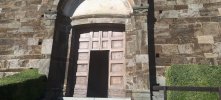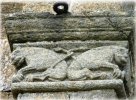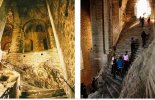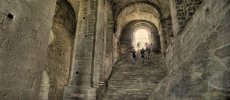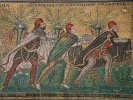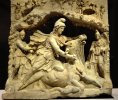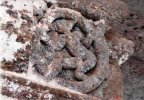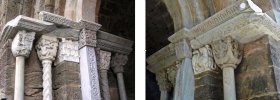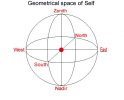ARCHANGEL MICHAEL
This was the thread upon which I first pulled and which led me off on the trail anew. For as I previously noted, the
Abbey of San Michele della Chiusa is also perhaps better known by the unusual title
Sacra di San Michele.
A “Sacra” means
a place literally consecrated by angels of fire; Greek name
Pir-Chirianos, that is
Fire of the Lord. The ancient name of Mount Pirchiriano was
Porcarianus, (mountain of
pigs), analogous with the neighboring Caprasio and Monte delle capre (
goats), and with Musinè (mountain of the
donkey). These names are suggestive of pre-Christian/pagan sacred roots as are the copious menhirs to be found in the surrounding district.
Local tradition has it that the name of the mountain was changed prior to the millennial year of 1000AD after a startling vision came to the bishop of Turin in which
he was raised atop its great peak by a ball of fire with angels astride, led by the Archangel Michael whereupon he was instructed to build a monastery. At the time the site was inhabited by a hermit, Giovanni Vincenzo, who had effectively already founded the first construction of the future
Sacra di San Michele. I will say more about the early years of the Abbey another time, but for now let us note that these founding fires were an integral part of its unique history and its association with the angel of flame, St Michael, the dragon slayer.
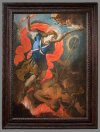 ST. MICHAEL / APOLLO
ST. MICHAEL / APOLLO
The true origins of the cult of St Michael have been lost in time but he appears to have emerged as a full fledged deity from somewhere in the east, possibly via Sythia, before arriving in the Middle-East, and was already flourishing at the time of late antiquity and the emergence of Christianity. The association with pre-Christian relics and monuments suggests that before this time, the character of 'St. Michael'
existed in a different form, and was connected to several significant events in the solar calendar.
He also appears at key moments in the Old Testament, especially of note being his
preventing Isaac from being sacrificed by his father through the substitution of a ram. It is said in the Bible that the name Michael (Mi-ka-el), originated when Lucifer (the fallen angel), compared himself with God, spurring another angel to stand before him and shout "Who is like God?", which in Hebrew translates as 'Mi-ka-el', after which he became known as Michael. In the
'Apocalypse' of apostle John, it was written that
a dragon with seven crowned heads and horns, and a tail that swept aside the stars, threatened the Virgin Mary and her newly born child. St. Michael and his angels
fought the serpent from Satan and destroyed it. Apep, the Seven-Headed Dragon of Egypt has been identified with Tiamat, the Great Dragon of Sumeria, slain by Marduk. This primordial goddess is also the prototype of the biblical monster Leviathan. Michael thus took up the status as Archangel, head of the heavenly host, the opponent of Satan and the fiery chief warrior of god. According to Roman legends, Archangel Michael
appeared with a sword over the mausoleum of Hadrian while a devastating plague persisted in Rome, in apparent answer to the prayers of Pope. Emperor
Constantine I made Michael the focus of an intense cult, dedicating the
Michalion to him in the 4th century, an imposing sanctuary built in Constantinople,
The pagan temple which had existed there had been previously associated with healing and medicine, and the Christians continued to associate the location and the Michaelion with healing waters..
and much later the emperor
Charlemagne dedicated the Holy Roman Empire to him, which was further imitated by the French sovereigns who, until Louis XIII, dedicated their kingdom to Michael.
All of this
hints at cometary links as well as at a close association with the function of Apollo as the
bringer of self-illumination through fire (and water), as a healer and as a messenger/interceder with the divine; the ultimate spiritual warrior. With his conflict against evil viewed
as the battle within, in this role Michael descends at the hour of death, and gives each soul the chance to redeem itself before passing, thus consternating the devil and his minions. Catholic prayers often refer to this role of Michael as he also weighs souls in his
perfectly balanced scales which he is often depicted holding.
His cult and veneration spread across Europe with the early church and also by route of Byzantium. Come the 4th century, he was firmly entrenched, from his foothold at a secluded hilltop cave on
Monte Gargano on the east coast of Italy, (where an apparition of the Archangel appeared around
490 AD… which is close enough to
the mid 6th century cometary bombardment in the north), then moved up through central Europe to France where it is said that St. Michael fought Satan on
Mont Dol in Brittany as well as inspiring with visions the mystical settlement in Normandy at
Mont St. Michel, finally onwards to England and the many notable Michael monuments such as
Dragon Hill before ending up (or perhaps commencing?) in Ireland on the remote South Western tip and the most elemental of all his conflicts with the devil on the isle of
Skellig Michael.
And here we come to a most notable alignment. Called the
Apollo/St Michael Axis, it stretches from the shores of Ireland south to Greece before piercing the Holy Land suggestively close to
the very place Armageddon is prophesied to commence.
A number of important and resonant sites are connected with this
‘arrow’ or
‘sword’ of Michael running
60 degrees, 11 minutes west of north through in particular these 5 pivotal sites relate specifically to the Archangel:-
- Skellig Michael (Co. Kerry, Ireland)
- St. Michael’s Mount (Cornwall, UK),
- Mont Saint Michel (Normandy, France),
- Sacra Di San Michele (the Italian Alpes),
- Monte Sant’ Angelo on the Gargano peninsula (Italy),
These align near perfectly (when you take the challenges of topography and place into account) with the five most important sites of Apollo, creating a extended pathway reminiscent of the
claim made by the ancient Greeks that twice a year Apollo would return to his place of origin in Hyperborea in the North .
- Delos – Apollo’s legendary birthplace,
- Delphi – main sanctuary of the same Greek god,
- Athens – the centre of the goddess Athena, with Apollo’s altar in the cave at the Acropolis.
- Kerkyra – Corfu, with the so-called Secret Temple of Apollo,
- Rhodes – the island of the Sun God, Helios/Phoebus, also identified with Apollo
What do these two characters, pagan Apollo and Christian Archangel Michael, have in common?
- They are both connected with the symbol of the ‘Sun’;
- Their legends give the same archetypal type of a dragon’s slayer;
- Whereas St Michael kills the devil in the disguise of the dragon, Apollo slays the famous Python, the serpent guardian of the Delphic oracle;
- Sometimes, Archangel Michael is even related to as the Christian counterpart of the Greek god of the sun, and furthermore his name itself means: “He who is like God”;
- Both characters, Apollo and St. Michael, possess high rocks or islands.
- (Broadhurst, Miller, Shanley, Russel 2003:1-4).
What is also quite interesting is the fact that the Monastery of Archangel Michael of Panormitis (Symi, Greece) was built around the fifth century AD “over the site of an ancient temple dedicated to the pagan god Apollo” (Sanidopoulos 2010). Accordingly, at least one of the sites of Saint Michael overlaps with an ancient site dedicated to Apollo. It is also observed that a few additional sites of the cult of Apollo or of Saint Michael are clustered around in the proximity of the main Line, yet not being directly crossed by its axis. For example, on Symi, most of the monasteries and churches scattered around the island are dedicated to Saint Michael (Sanidopoulos 2010). The same phenomenon appears in France, where the Archangel is venerated as the patron saint. Similar multiplicity of Apollo’s temples is noticed on the Greek islands.
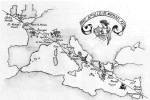
Other references highlight a total of
7 ancient monastic sites strung out along the line, namely:
- Skellig Michael (Ireland),
- Saint Michael’s Mount (UK),
- Mont Saint Michel (France),
- Sacra Di San Michele (Italian Alpes),
- Monte Sant’ Angelo on the Gargano peninsula (Italy),
- Archangel Michael of Panormitis (Symi, Greece – in the north-west of Rhodes),
- Stella Maris Monastery (Israel)
After the Book of Enoch, which is the apocrypha to the Bible, “St. Michael appears to be a protector of [seven] mountains and the Tree of Life that is located on one of [them]” (Kosloski 2019). According to the same tradition, “an imaginary line links seven different monasteries from Ireland to Israel, [which are all dedicated to the Archangel] (Ibid.). Usually, it is called the Sacred Line/Axis of St. Michael, St. Michael’s Line/Axis or the Sword of St. Michael (Ibid.). The latter is clearly a reference to Saint Michael as the Archangel with the sword and His victorious fight with the devil, usually represented as a dragon speared with the sword under His feet (Ibid.).
…if “the curvature of the earth [is taken] into account, the [Line] ends at the ‘Gates of Hell’ at the foot of Mount Hermon” (Michael 2018), situated between Syria and Lebanon and north to Mount Carmel. The Book of Enoch (Enoch 6:1-6) describes the legendary Mount Hermon as the place where fallen angels descended to earth or, after the Revelation (Rev.12:7–10), they were cast down from Heaven by Saint Michael and His angelic army. According to other sources, however, the last point of the Axis should be Megiddo Tell (in Greek known as Armageddon – the location of the final battle between the good and evil), lying close to Mount Carmel (Broadhurst, Miller, Shanley, Russel 2003: 347-366) Consequently, “the remarkable alignment of all the [places] is perceived as a sign, pointing to an apocalyptic battle between St. Michael and [the devil]” (Kosloski 2019).
“Bearing in mind the distance from the west of Ireland to the Holy Land, some 2,500 miles, [around 4,024 km], and the fact that many of the sites are natural landmarks, sanctifies by nature rather than by human choice, the straight path on which they all stand is indeed narrow” (Broadhurst, Miller, Shanley, Russel 2003:12). Nonetheless, it can be observed that the closer the Line a particular site is located, the more significant it seems in terms of the cult and heritage.
Further worthy of note is the fact that Mont Saint Michel (Normandy), the Sacra Di San Michele (Italian Alpes), and Monte Sant’ Angelo on the Gargano peninsula (Italy), are equidistant from each other forming
a further pattern of 3 nearly exactly 2,000km in length with
Sacra Di San Michele at the 1000km mark. And all three places commenced with a burning visitation from the Archangel:
Mont Saint Michel
As a legend goes, in 708 Aubert, the bishop of Avranches had in his dream a vision of the Archangel Michael who instructed him to build an oratory on the large isolated rocky islet (Harpur, Westwood 1997:166).
Monte Sant’ Angelo
According to a legend, the grotto was dedicated to Saint Michael as the Archangel had appeared there three times, in 490, 492 and 493 (Ibid.). Additionally, in 2019 archaeologists of the Ludwig Maximilian University excavating the site announced their discovery of traces of Hellenistic temple dated to the second century B.C. (Ibid.).
Many researchers speak of Ley lines and earth energies but I can’t help wondering whether
there might be a connection to the flight path of an earth skimming comet – either one honoured from deep antiquity… or in some prophetic manner, anticipated by this line in our not too distant future… ???!
Anyway, as you can see, our site exists within a framing context way larger than its own locality and history.
Each of these myriad sacred places has a remarkable story to tell and a location of mysterious origination, but none quite like the legacy still to be found at the
Sacra Di San Michele.




